|
 Humidicutis conspicua Humidicutis conspicua
SynonymsHygrocybe conspicua
BiostatusPresent in region - Indigenous. Endemic
Images (click to enlarge)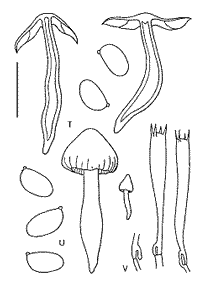
Caption: Fig. 46 Humidicutis conspicua (Horak) Horak (T-V: PDD 27079,
type):T. basidiomes. U. spores. V. basidia. | 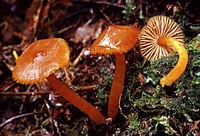
Caption: Humidicutis conspicua
Owner: Kaimai Bush | 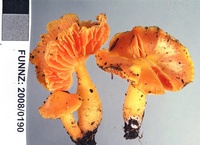
Owner: J.A. Cooper | 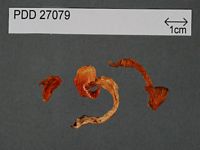
Caption: Dried type specimen
Owner: Herb PDD | 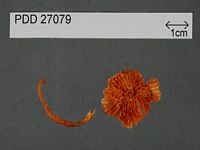
Caption: Dried type specimen
Owner: Herb PDD | 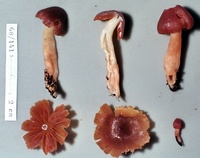
Caption: ZT68-141 , Holotype
Owner: E. Horak: © Creative Commons Attribution-Noncommercial 3.0 New Zealand | 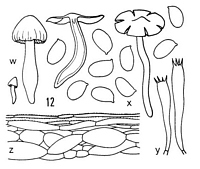
Caption: Hygrocybe conspicua Hk. (type): w. carpophores. - x. spores. - y. basidia. - z. cuticle |
Article: Horak, E. (1973). Fungi Agaricini Novazelandiae I-V. Beihefte zur Nova Hedwigia 43: 200 p.
Description: Pileus 5-35 mm diam., conic when young becoming convex and then umbonate-expanded, occasionally margin of pileus upturned, deep orange to red-brown, darker at the centre, fading to pink-yellowish-brownish, subviscid to dry, margin slightly striated, glabrous, pellicle separable. Lamellae adnexed to emarginate-adnate, brilliant orange, especially at the even gill edge, turning deep ochraceous, moderately distant. Stipe 15-75 x 3-7 mm, fusoid, often curved, apex yellowish or whitish, pinkish-yellow-orange towards the base, dry, glabrous, hollow, single. Context apricot-yellow. Taste and odor unpleasant, like rotten meat. Chemical reactions on pileus: KOH orange, NH3 and HCl- negative.
Spores 6-7 x 4-4.5 µm, ovoid, smooth, inamyloid. Basidia 32-46/5-6 µm, 4-spored. Cystidia lacking. Cuticle a cutis consisting of repent, cylindric, slightly gelatinized hyphae (5-10 µm diam.), occasionally interwoven, encrusted with pigment. Clamp connections absent on cuticular hyphae.
Habitat: In soil amongst litter of Nothofagus (N. menziesii, N. fusca) and Dacrydium cupressinum. New Zealand.
Notes: The characters of this species are so conspicuous that it can be identified at once in the felt. H. conspicua Hk. was observed on several occasions both in Nothofagus and Podocarpus forests along the Westcoast of South Island.
Article: Horak, E. (1990). Monograph of the New Zealand Hygrophoraceae (Agaricales). New Zealand Journal of Botany 28(3): 255-306 (http://www.rsnz.org/publish/abstracts.php).
Description: Pileus -35 mm, conical becoming and finally umbonate-expanded, margin splitting
in aged specimens; brilliant orange to red-brown, darker at disc, fading to
pink with pale yellow-brown tinge; viscid to lubricous when moist, hygrophanous,
slightly striate al margin, glabrous, cartilaginous. - Lamellae 14-18 (1-3),
moderately distant, adnexed to emarginate-adnexed; brilliant orange (especially
at the entire edges) turning pale ochre in age. - Stipe 15-75 x 3-15 mm, cylindrical,
equal to fusoid, often curved; apex white to pale yellow, pink-yellow orange
towards base; dry, glabrous, hollow, single. - Context apricot-yellow, brittle.
- Odour and taste unpleasant, like rotten meat. - Chemical reactions on pileus:
KOH - orange, HCI and NH3 - negative.
Spores 6-7 x 4-4.5 um, ovoid. - Basidia 32-46 x 5-6 um, 4-spored, with medallion-like
clamp connection at basal septum. - Cystidia absent. - Pileipellis a cutis of
repent, cylindrical hyphae (2-4 um diam.), hyaline membranes not gelatinised,
encrusted with pigment, cells of subcutis fusoid to ovoid; aborted clamp connection
rarely present on septa of cuticular hyphae (Pl. 1, Fig. 8).
Habitat: ECOLOGY: Scattered; saprobic on very rotten wood or on soil among litter in
broadleaved (Nothofagus fusca-N. menziesii, Quintinia) and conifer forests
(Dacrydium cupressinum). December-April.
Distribution: DISTRIBUTION: NZ (WL).
Notes: The re-examination of the type material demonstrated that clamp connections
are actually present at the basidial septa and thus Humidicutis conspicua
unmistakeably belongs to Humidicutis.
The brilliant orange lamellae and the general habit of the basidiomes are strongly
reminiscent of the common North American H. marginata (Peck) Sing. which
represents the type species of the genus Humidicutis. These two closely
related taxa, however, are readily separated both by their ecology and distribution
pattern and the size of the spores.
|